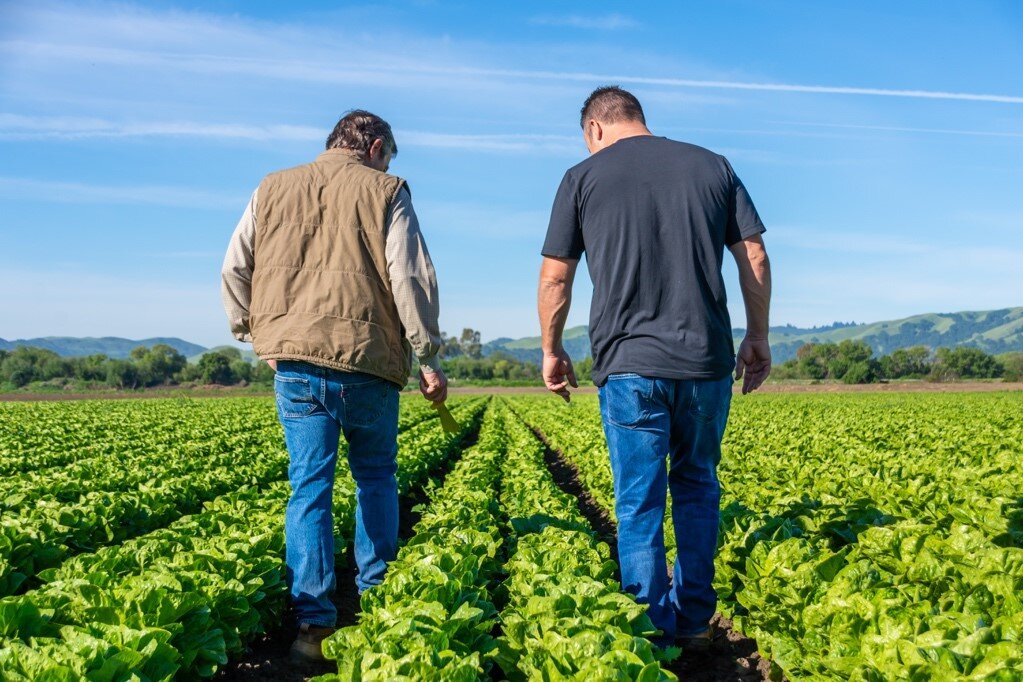When the farm-to-table topic comes up in a conversation, you think of an abundance of fresh produce and healthy meals. You read about it in a restaurant review and picture generous servings of vibrant, locally sourced veggies and pasture-raised meats.
But what does the term actually mean?
Let's dive into the banquet of information, history and benefits served up by this important food concept.
What Does Farm-to-Table Mean?
Farm-to-table is a food concept and an agricultural process. It connects consumers with fresh, healthy produce and proteins. While it's often thought of as a direct link between local farms and consumers, the movement encompasses a wide range of suppliers.
The simplest definition of farm-to-table is food that moves directly from fields to commercial or home kitchens. It isn't supplied through traditional means such as wholesale or retail vendors. However, the term isn't regulated.
The phrase, farm-to-table, can refer to food sourced locally from small or large operations. It can also be applied to vegetables and meats sourced through farmers markets and community agricultural projects.
In general, farm-to-table means that the food on your plate was purchased directly from the grower, but how can you be sure? How do you know the vegetables you purchase are sourced from farm-to-table operations? A restaurant promotes a menu designed around farm-to-table ingredients, but can that be confirmed?
The simplest way to be sure is to ask straightforward questions and listen for direct answers.
A vendor at the farmers market should be happy to share information. Ask restaurant staff front and back of house which suppliers they use. The relationships between growers and sellers serve as the pipelines that make farm-to-table possible. Your inquiries and feedback can serve as an invaluable part of the process.
A History of the Farm-to-Table Movement
Hitchcock Farms’ President Jeff Hitchcock
When our nation was young, farmers and surrounding towns were connected by the simple basics of supply and demand. Veggies, milk, eggs and meats were typically available from a farmer just down the road.
As cities grew, populations shifted to urban landscapes. The distance between growers and markets naturally increased. By the early 1900s, food was routinely shipped from farm to market by train and truck.
It was during this time that the concept of farm-to-table began to take shape. The idea was to reestablish direct distribution from grower to consumer. These are some of the historic highlights:
1915 - The U.S. Postal Service initiated food shipments from farm to city via parcel post.
1940s - The majority of the country's population settled in urban centers away from farming operations.
1950s - Commercially processed, canned and frozen foods became widely available.
1960s - Consumers began looking for alternatives to traditional supermarket vegetables and proteins.
1971 - Chef Alice Waters opened Chez Panisse, one of California's first restaurants featuring farm-to-table fare.
2007 - The National Farm to School Network was established to connect schools with farm-to-table food sources.
Why Is Farm-to-Table Important?
The farm-to-table concept, once considered just a trend is now recognized as an important working component of agricultural sustainability. The production involved in farm-to-table operations helps maintain environmental protections that preserve fertile fields and clean water sources.
Farm-to-table also plays a role in economic and community sustainability. It strengthens connections between growers, the foodservice industry and consumers. From farmers and restaurant staff to home chefs, we're all part of a process that promotes best growing practices and results in a healthier food supply.
What Is a Farm-to-Table Restaurant?
A farm-to-table restaurant typically features ingredients sourced directly from growers. Produce can come from a small, family farm or a larger operation that adheres to sustainable agricultural practices. Produce is often delivered shortly after harvest, and is fresher and more flavorful.
Suppliers might include area ranchers, dairy farmers and local fishermen. The connections between food sources and commercial kitchens remain direct. Often, a restaurant chef establishes a supply network that allows him or her to develop signature menus featuring specialty dishes.
The farm-to-table model is beneficial for everyone involved.
Farmers gain a reliable market for their products. Chefs enjoy fresher ingredients and a relationship with the farmer, knowing how their produce and meats were grown and raised.
Restaurant guests enjoy meals prepared with fresh, quality ingredients. This process harkens back to simpler days and promotes responsible farming practices, transparency and a healthier way of eating.
What Are the Benefits of Farm to Table?
Hitchcock Farms’ baby iceberg lettuce
There are four principle benefits that anchor the farm-to-table concept.
1. Enhanced Food Security – An improved supply chain between growers and communities
2. Less Physical Distance – Reduced environmental impact from food transportation operations
3. More Self-Reliance – Increased community ability to source a dependable food supply
4. Food System Sustainability – Best growing practices that foster environmental conservation
These four fundamentals represent the biggest farm-to-table benefits, but there are other advantages as well. Small restaurants, large commercial kitchens and even caterers can reap additional benefits from this specialized foodservice model. These are just a few examples.
Cooperative and profitable relationships between growers and foodservice professionals
Reliable sources for a variety of fresh, quality produce and proteins available from established growers
Greater flexibility for designing healthy menus in all types of restaurant business models
Access to seasonal items for planning specialty dishes that bring in customers through promotional LTOs.
Reduced environmental impact from carbon footprints, especially in farm-to-table transportation
Increased agricultural sustainability developed through innovations, such as regenerative agriculture.
What Are the Challenges of the Farm-to-Table Process?
As we've noted, farm-to-table has transitioned from trend status to a viable and positive force in the foodservice industry. Still, as the process evolves, it faces specific challenges.
False Authenticity – Restaurant operations that falsely claim to serve farm-to-table eventually create consumer skepticism.
Lack of Regulatory Certification – There are currently no industry-certified standards that can discourage false claims of farm-to-table authenticity.
Seasonal Challenges – Restaurants constantly adapt menus to incorporate seasonal changes; however large operations can supply most fresh produce year-round.
Higher Food Costs – Small growers in the farm-to-table system deal with higher production costs, and that can impact a restaurant's bottom line.
Consumer Misconceptions – Most consumers assume farm-to-table starts with small operations, but large growers and shippers are also a part of the process.
As farm-to-table operations continue to expand, growers, suppliers, vendors and restaurants continue to develop solutions to current problems. The industry remains strongly committed to a future that will encompass foodservice professionals in all categories.
How Is the Farm-to-Table Movement Changing in 2025?
Consumer preferences can change from year to year, but their appetite for authentic dining experiences holds strong. Look for the 2025 farm-to-table industry to continue satisfying their expectations as it evolves with these changes.
Farm-to-table will grow its consumer base through fast-casual restaurants similar to Tender Greens, located in California.
The movement will enhance consumer confidence with its impact on food waste reduction through eco-friendly operations.
Farming operations will adapt to the ongoing climate changes that impact their operations and pricing structures.
Regenerative agriculture will increase as more and more growers become a part of the farm-to-table movement.
Continued growth spurred by consumer satisfaction will result in innovations that consistently deliver high-quality ingredients at lower costs.
How Does Farm-to-Table Fit in Home Kitchens?
Home chefs can easily be a part of the farm-to-table movement. The concept remains firmly established even in large urban areas.
If you're interested in farm-to-table meal planning at home, put technology to work. Search online for farmers markets, agricultural projects and produce growers near you.
Explore farm-to-table ideas that celebrate seasonal fruits and vegetables. Try out new recipes that make the most of farm-fresh produce and proteins. Learn more about new ways to solve old food problems. For example, eco-friendly root-to-stalk cooking is a direct offshoot of the farm-to-table movement.
Each time you prepare a farm-to-table meal, you know you're making a positive difference. You're supporting a food system that benefits your family, the local economy and the planet. That's a great fit for every home kitchen.
Our Roots as Family Farmers
The farm-to-table movement isn’t just a trend. It’s a way to celebrate and honor our food, caring about how and where it is grown. It’s an ode to the farmers, who toil away in the fields, in an effort to grow the most delicious ingredients. It’s a simpler way of living and eating.
In the words of the great Alice Waters, “If you have the best and tastiest ingredients, you can cook very simply and the food will be extraordinary because it tastes like what it is.”
We’re proud of our roots as Salinas Valley family farmers. We’ve been a part of the local agricultural community for many generations, and enjoy working closely with chefs who seek out our produce to supply their farm-to-table restaurants.
From our fields to your fork, we look forward to continuing the movement toward local, sustainable, and responsible farming practices.









